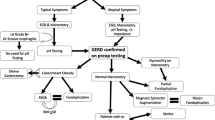Abstract
Background Balloon dilatation of the lower esophageal sphincter (LES) is one of the effective nonsurgical treatment options in the management of achalasia. We aimed to determine the long-term results of graded balloon dilatation and the factors predicting outcome. Patients Patients followed for more than 12 months between January 1995 to March 2005, without history of endoscopic or surgical therapy before the study, were included (n = 111, mean age 46.3 ± 16.9 years; follow-up period 46.3 [12–150] months). Patients were evaluated by barium swallow contrast studies, upper endoscopy, and esophageal manometry. Pneumatic dilatation was performed with the use of polyethylene balloon system. Patient outcome was evaluated according to manometric studies and Van Trappen staging as determined following face-to-face interviews with the patients. Results We determined clinical response rates of 98%, 85.7%, and 75% at months 24, 48, and 60. According to receiver-operating characteristics (ROC) analysis, age ≤37.5 years, LES pressure (LESP) ≥30.5 mmHg, LESP after first balloon dilatation ≥17.5 mmHg, and balloon number >2 were found to negatively affect treatment response. Young age and higher esophageal body pressure at admission were determined to be negative predictive factors (P = 0.038, relative risk (RR) 2.6, 95% confidence interval [CI] 1.05–6.4 and P = 0.05, RR 1.069, 95% CI 0.99–1.14, respectively). Conclusion Balloon dilatation is an effective treatment of achalasia. Young age, higher esophageal body pressure, and high LESP after first balloon dilatation are negative predictive factors. Patients with young age requiring more than two balloon dilatations are likely to be unresponsive to the treatment.




Similar content being viewed by others
References
Reynolds JC, Parkman HP. Achalasia. Gastroenterol Clin North Am. 1989;18:223–255.
Vantrappen G, Janssens J, Hellemans J, Coreman G. Achalasia, diffuse esophageal spasm and related motility disorders. Gastroenterology. 1979;79:450–461.
Vaezi MF, Richter JE. Diagnosis and management of achalasia. Am J Gastroenterol. 1999;94:3406–3412. doi:10.1111/j.1572-0241.1999.01639.x.
Vantrappen G, Janssens J. To dilate or to operate? That is the question. Gut. 1983;24:1013–1019. doi:10.1136/gut.24.11.1013.
Vantrappen G, Hellemans J. Treatment of achalasia and related motor disorders. Gastroenterology. 1980;79:144–154.
Eckardt VF, Gockel I, Bernhard G. Pneumatic dilation for achalasia: late results of a prospective follow up investigation. Gut. 2004;53:629–633. doi:10.1136/gut.2003.029298.
Chan KC, Wong SKH, Lee DW, et al. Short-term and long-term results of endoscopic balloon dilation for achalasia: 12 years’ experience. Endoscopy. 2004;36:690–694. doi:10.1055/s-2004-825659.
Goldenberg SP, Burell M, Fette GG, et al. Classic and vigorous achalasia: a comparison of manometric, radiographic and clinical findings. Gastroenterology. 1991;102:743–748.
Csendes A, Braghetto I, Henriquez A, et al. Late results of a prospective randomised study comparing forceful dilation and oesophagomyotomy in patients with achalasia. Gut. 1989;30:299–304. doi:10.1136/gut.30.3.299.
Parkman HP, Reynolds JC, Quyang A, et al. Pneumatic dilation or esophagomyotomy treatment for idiopathic achalasia: clinical outcomes and cost analysis. Dig Dis Sci. 1993;38:75–85. doi:10.1007/BF01296777.
Katz Po, Gilbert J, Castell DO. Pneumatic dilation is effective long-term treatment for achalasia. Dig Dis Sci. 1998;43:1973–1977.
West RL, Hirch DP, Bartelsman JF. Long term results of pneumatic dilation in achalasia followed for more than 5 years. Am J Gastroenterol. 2002;97(6):1346–1351. doi:10.1111/j.1572-0241.2002.05771.x.
Karamanolis G, Sgouros S, Karatzias G, et al. Long term outcome of pneumatic dilation in the treatment of achalasia. Am J Gastroenterol. 2005;100:270–274. doi:10.1111/j.1572-0241.2005.40093.x.
Ghoshal UC, Kumar S, Saraswat VA, et al. Long-term follow-up after pneumatic dilation for achalasia cardia: factors associated with treatment failure and recurrence. Am J Gastroenterol. 2004;99:2304–2310. doi:10.1111/j.1572-0241.2004.40099.x.
Wong RKH, Maydoavitch CL. Achalasia. In: Castell DO, ed. The Esophagus. New York: Little Brown, 1995: 219–247.
Vakil N, Kadakia S, Eckardt VF. Pneumatic dilation in achalasia. Endoscopy. 2003;35:526–530. doi:10.1055/s-2003-39668.
Ellis FH. Esophagectomy for achalasia: who, when, and how much? Ann Thorac Surg. 1989;47:334–335.
Orringer MB, Stirling MC. Esophageal resection for achalasia: indications and results. Ann Thorac Surg. 1989;47:340–345.
Zwischenberger JB, Savage C. Megaesophagus from a 26-year history of achalasia. Ann Thorac Surg. 2000;69:1597. doi:10.1016/S0003-4975(00)01181-4.
Borotto E, Gaudric M, Danel B, et al. Risk factors of oesophageal perforation during pneumatic dilatation for achalasia. Gut. 1996;39:9–12. doi:10.1136/gut.39.1.9.
Eckardt VF, Aienherr C, Bernhard G. Predictors of outcome in patients with achalasia treated with pneumatic dilation. Gastroenterology. 1992;103:1732–1738.
Author information
Authors and Affiliations
Corresponding author
Rights and permissions
About this article
Cite this article
Dağlı, Ü., Kuran, S., Savaş, N. et al. Factors Predicting Outcome of Balloon Dilatation in Achalasia. Dig Dis Sci 54, 1237–1242 (2009). https://doi.org/10.1007/s10620-008-0493-6
Received:
Accepted:
Published:
Issue Date:
DOI: https://doi.org/10.1007/s10620-008-0493-6




